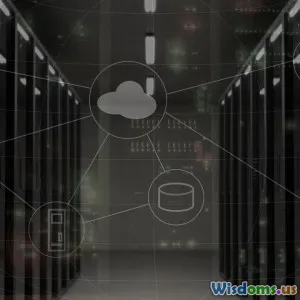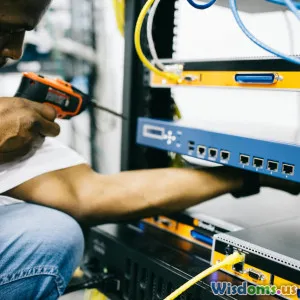
Comparing Rack and Blade Servers Which Is Best
10 min read An in-depth comparison of rack vs blade servers to determine which suits your business needs best. (0 Reviews)
Comparing Rack and Blade Servers: Which Is Best?
In today's enterprise environment, where data and compute demand are ever-growing, choosing the right server infrastructure is paramount. IT decision-makers are often torn between rack and blade servers, each touting advantages but also facing limitations. This article dives deeply into their design, functionality, real-world applications, and cost-effectiveness to help determine which server type reigns supreme—or if the winner depends on context.
Understanding the Server Landscape: Rack vs Blade
Rack Servers: The Standalone Workhorses
Rack servers are traditional, self-contained servers mounted within a standardized rack enclosure, typically 19 inches wide. Each unit usually occupies 1U to 4U of rack space (where "U" is 1.75 inches).
These servers come as complete boxes with CPU, memory, storage, power supply, and networking components. Administrators insert these servers into data center racks, connecting them via standard cabling.
Rack servers have a strong track record dating back decades and dominate many midsize to large data centers due to their versatility and simplicity.
Example: The Dell PowerEdge R740 is a popular 2U rack server widely adopted for virtualization and database workloads.
Blade Servers: The Modular Innovators
Blade servers represent a more compact and integrated approach, whereby multiple server modules (blades) slide into a shared chassis that provides power, cooling, networking, and management.
A blade itself is stripped down compared to a traditional rack server; it typically contains only compute elements like CPU, memory, and local storage components. The shared chassis reduces redundancy and cabling clutter.
Blades emphasize high density and efficient resource sharing and are a staple in environments with limited space but high compute demands.
Example: HPE’s BladeSystem c7000 chassis can house up to 16 half-height blades in a 10U form factor.
Architectural Differences and Their Implications
Space Efficiency
Rack Servers: Offer straightforward scaling; you add servers as 1U or multi-U blocks. However, this means more cabling and potentially more physical room.
Blade Servers: Their high-density design can reduce rack space by up to 50-70%. Because blades share power and cooling, the chassis is compact, saving valuable data center floor space.
Insight: For a 42U rack, a rack server deployment might install 40-42 servers (1U each), whereas a blade chassis occupying 10U might hold 16-20 servers, offering denser compute power.
Power and Cooling
Rack Servers: Each server has its own power supplies and fans, leading to potentially higher overall energy consumption and heat output.
Blade Servers: Shared infrastructure leads to efficiency gains. According to a 2022 survey by Uptime Institute, blade servers can reduce power consumption by 20-30% compared to an equivalent rack server setup.
Real-World Impact: Organizations targeting green IT and minimizing operational costs often favor blades for their inherent efficiencies.
Manageability and Deployment
Rack Servers: Individually managed; IT admins handle firmware, updates, and networking per server. Tools like HP iLO or Dell iDRAC provide remote management.
Blade Servers: Centralized management through the chassis simplifies configurations, firmware updates, monitoring, and orchestrated deployments.
Case Study: A financial firm reported reducing server provisioning time by 40% after adopting blade infrastructure due to centralized management.
Scalability and Flexibility
Rack Servers: Flexible—you can mix various configurations and easily replace individual servers. Ideal for heterogeneous environments.
Blade Servers: Scaling is somewhat constrained by the chassis slot count but allows swift mid-capacity growth if chassis space is available.
Cost Factors
At face value, rack servers often come with lower initial purchase prices per unit. But when considering rack space, power, cooling, and cabling, total cost of ownership (TCO) varies.
|
| Cost Element | Rack Servers | Blade Servers |
|---|---|---|
| Initial Hardware Cost | Lower per server | Higher per blade unit + chassis expense |
| Installation & Cabling | More complex, more cables | Simplified with shared chassis |
| Power & Cooling | Higher per server individually | Shared systems reduce overall consumption |
| Management | Decentralized, higher labor cost | Centralized, reduced administrative effort |
Data Point: For a deployment of 100 servers, a 4-year TCO study by Gartner in 2023 indicated blade infrastructures saved enterprises an average of 18% compared to rack servers when factoring energy and management.
Performance Considerations
Both rack and blade servers typically use high-performance components, so raw compute power often depends on the CPU and memory configurations rather than the chassis.
However, bandwidth and latency for internal communications differ:
-
Blade servers facilitate better inter-blade communication via chassis backplanes, benefiting clustered workloads and services requiring low-latency exchanges (e.g., HPC, virtualization clusters).
-
Rack servers rely on external network switches, potentially increasing latency.
Example: VMware environments often leverage blade chassis with integrated high-speed networking fabric to optimize VM migrations and clustering.
When to Choose Rack Servers
- Organizations needing flexible, easily replaceable individual servers.
- Data centers with priority on diversity of hardware configurations.
- Environments where incremental scaling is preferred over acquiring a large chassis.
- Firms operating on tight initial capital expenses where per-server cost dominates.
Illustrative Case: A startup developing new software platforms opted for rack servers initially to quickly iterate hardware setups.
When to Choose Blade Servers
- Enterprises with critical space constraints seeking dense compute power.
- Companies emphasizing energy-saving and simplified data center management.
- Large-scale virtualization and cloud providers needing centralized administration and fast scaling.
- Environments that benefit from server blade clustering and optimized blade communication.
Illustrative Case: A multinational bank utilizes blade server farms to support massive virtual desktop infrastructure (VDI) workloads efficiently.
The Hybrid Reality
Increasingly, organizations adopt hybrid models leveraging both rack and blade servers based on workload demands and infrastructure strategies.
For instance, critical, latency-sensitive applications might run on blade servers, while general-purpose, less dense workloads go to rack servers.
Hybrid strategies maximize benefits from each type while mitigating limitations, underscoring flexibility as a modern infrastructure imperative.
Conclusion: No One-Size-Fits-All Answer
Choosing between rack and blade servers is less a matter of universally "best" and more about aligning technical capabilities with business needs. Rack servers present a lower upfront cost and great flexibility, making them a pragmatic choice for many. Blade servers excel in maximizing density, energy efficiency, and streamlined management, suiting enterprises aiming for optimized, large-scale operations.
Decision-makers should undertake a thorough analysis of:
- Physical data center constraints
- Power and cooling capacities
- Current and forecasted workloads
- Management resource availability
- Budget scope
Armed with this knowledge, IT leaders can architect their server infrastructure confidently, ensuring their data centers are future-ready, cost-effective, and performant.
As technology evolves, so will server designs — but making an informed choice today sets the foundation for tomorrow’s innovation.
Rate the Post
User Reviews
Popular Posts


















